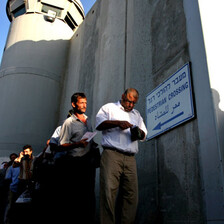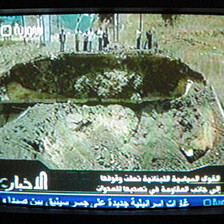The Electronic Intifada 28 May 2003
The exhilaration of some over Israeli Prime Minister Ariel Sharon’s utterance of the word occupation after over three decades of iron fist military control of the Palestinian people and their land has, like Israel’s conditioned acceptance of the U.S.-drawn road map, received much undeserved credit. The rush to embrace Israeli leaders and their political statements has become a hallmark of the majority of U.S. officials and unfortunately the U.S. media.
Although Sharon was quick to clarify his unique understanding of occupation — Israeli control over the Palestinian people and not the Palestinian lands — those who do, or choose to ignore international and humanitarian law and conventions, and the concept of justice and lasting peace, will continue to champion Sharon’s “generous” use of vocabulary and his “courage” to formally accept the U.S. road map.
Furthermore, in their euphoria, they will dismiss the fact that Sharon’s definition of occupation contradicts the established international understanding of occupation. One should also keep in mind that Sharon’s delayed acceptance of the road map came after a fourteen-point alteration to the U.S. plan.
This unjustified euphoria is not new. In 2000, U.S. politicians and the media jumped on the bandwagon of then-Israeli Prime Minister Ehud Barak hailing him as a true leader-someone who “dared” to go beyond what is expected of an Israeli leader when he agreed to discuss the issue of east Jerusalem and Palestinian refugees.
What they failed to mention was that Barak’s generosity fell below the minimum rights guaranteed to the Palestinians by international law. East Jerusalem, like the West Bank and Gaza, was occupied in 1967 and must be addressed in the same status during negotiations. UN resolutions grant Palestinian refugees the right to return to their ancestral homes, not a return to a newly created Palestinian state in yearly quotas set by Israel. The message to Israel then as it is now, is that it can remain a country above international law, unencumbered by UN resolutions and insensitive to international consensus.
Sharon’s declared understanding of occupation is in direct contradiction with the road map with which he says he is willing to work. Sharon does not recognize the West Bank and Gaza Strip as occupied land. According to Sharon, they are “disputed” lands. By using the word disputed when referring to the Palestinian territories, Sharon is attempting to convince the international community that Israel has a right to these lands and can decide their future status from a position equal to that of the Palestinians. He is disregarding the fact that in the eyes of the international community, the Palestinians are an occupied people negotiating an end to the occupation of their homeland. Furthermore, he is suggesting that Israel’s presence in the Palestinian territories is backed by international law rather than condemned by international consensus.
By not recognizing the occupation of the land, Sharon is saying he will not recognize the Palestinians’ right to a state, even a provisional one as the road map calls for. When Sharon states that he expects the Palestinians to abandon their right of return to their ancestral homes, he is dictating to the Palestinians the rules of the game and denying them their international right of repatriation.
Sharon’s alterations to the U.S. road map will certainly complicate its implementation. To many Palestinians the road map, in its original form, is more of a roadblock to peace. Its ambiguity and the series of conditions it places on the Palestinians for which in return they will probably get a phased Israeli military withdrawal from the heart of their cities, villages, and refugee camps and eventually a provisional state, is not the road to freedom. If the Palestinians wanted autonomy over their daily chores, they would have accepted Camp David I in the 70s or one of several non-starter plans that have been pushed on the Palestinians since the creation of Israel in 1948.
Why create new plans for the same crisis? Why keep reinventing the wheel? There is an internationally agreed upon foundation for solving the conflict. International law and conventions and UN resolutions have paved the road to peace, no maps needed.
The comprehensive settlement to the conflict is embodied in United Nations Resolutions 242 and 338, accepted by the Palestinians and Israelis at the Madrid Conference in 1991 as the basis of a future settlement. The resolutions call for the withdrawal of Israel to the 4 June 1967 border, including from east Jerusalem. The Palestinians thus will be able to establish an independent state on only 22 percent of their historic homeland. To attain just and lasting peace between Palestinians and Israelis, there must be two viable, independent, and secure states living as equal neighbors and a just solution to the Palestinian refugee issue. Anything short of this, will only create a new process, devoid of the substance needed to stop the violence and to launch the region into a state of peace, security, and prosperity.
If Sharon is truly interested in putting the Palestinian-Israeli conflict to rest he should expand his vocabulary when addressing the Palestinians to include the following terms: freedom, statehood, viability, justice, and equality.
Samar Assad is the Publications Manager of the Palestine Center.




